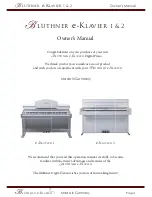
Voice Selectors
The YPP-50 has eight voice selectors. Simply press any of
the voice selectors to select the corresponding voice. The
LED indicator above the voice selector will light to indicate
which voice is currently selected.
l
The Bass Split Mode:
The YPP-50 Bass Split Mode allows
the BASS voice to be played on all keys to the left of
and including the F
#
2
key, and any other voice to played
on all keys to the right of the F
#
2
key. To activate the
Bass Split mode and select the right-hand voice, hold
down the BASS voice selector and press the voice selector
corresponding to the desired right-hand voice, then release
both voice selectors. Both the BASS LED and the LED
of the selected right-hand voice will light. Please note that
the damper pedal does not affect the bass voice in the
Bass Split mode. The Bass Split mode can be disengaged
and the normal voice mode restored by simply pressing
any single voice selector.
Note:
The PIANO voice is automatically selected whenever the
POWER switch is initially turned ON.
PERFORMANCE MEMORY REC and PLAY Buttons
These buttons activate the YPP-50 Performance Memory
record and playback functions. Operation of the Performance
Memory is described in detail on page 9.
DEMO Button
Press the DEMO button to hear the YPP-50’s pre-programmed
demonstration. Further details are given on page 8.
HEADPHONE Jack
A standard pair of stereo headphones can be plugged in here
for private practice or late-night playing. The internal speaker
system is automatically shut off when a pair of headphones
is plugged into the HEADPHONE jack.
OPTIONAL IN L/R and OUT L/R Jacks
These jacks are intended primarily for use with Yamaha EM-
series Expander Modules such as the EME-1 Reverb Box,
EMT-1 FM Sound Box, EMT-10 AWM Sound Box and
EMR-1 Drum Box. In the case of the EME-1 Reverb Box,
for example, the OPTIONAL OUT jacks connect to the
EME-1 LINE IN jacks, and the EME-1 LINE OUT jacks
connect back to the Personal Electronic Piano OPTIONAL
IN jacks. This allows application of a range of high-quality
digital effects, including reverb and echo, to the Personal
Electronic Piano sound. Refer to the EM-series Expander
Module device owner’s manual for connection details.
DAMPER Jack
The supplied damper pedal (Yamaha FC-5) should be plugged
in here. The damper pedal functions in the same way as a
damper pedal on an acoustic piano. When the damper pedal
is pressed notes played have a long sustain. Releasing the
pedal immediately stops (damps) any sustained notes.
MIDI IN and OUT Connectors
The MIDI IN connector receives MIDI data from anexternal
MIDI device (such as the EMQ-1 Memory Box) which can
be used to control the Personal Electronic Piano. The MIDI
OUT connector transmits MIDI data generated by the Per-
sonal Electronic Piano (e.g. note and velocity data produced
by playing the Personal Electronic Piano keyboard).
More details on MIDI are given in “MIDI FUNCTIONS”
on page 10.
7
Summary of Contents for YPP-50
Page 5: ...3 ...
Page 7: ...5 ...
Page 19: ...YAMAHA YAMAHA CORPORATlON P O Box 1 Hamamatsu Japan 909 VI27370 Printed in Japan ...




































